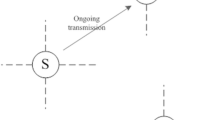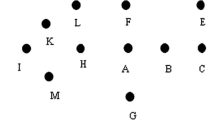Abstract
We address deafness and directional hidden terminal problem that occur when MAC protocols are designed for directional antenna based wireless multi-hop networks. Deafness occurs when the transmitter fails to communicate to its intended receiver, because the receiver’s antenna is oriented in a different direction. The directional hidden terminal problem occurs when the transmitter fails to hear a prior RTS/CTS exchange between another pair of nodes and cause collision by initiating a transmission to the receiver of the ongoing communication. Though directional antennas offer better spatial reuse, these problems can have a serious impact on network performance. In this paper, we study various scenarios in which these problems can occur and design a MAC protocol that solves them comprehensively using only a single channel and single radio interface. Current solutions in literature either do not address these issues comprehensively or use more than one radio/channel to solve them. We evaluate our protocol using detailed simulation studies. Simulation results indicate that our protocol can effectively address deafness and directional hidden terminal problem and increase network performance.
















Similar content being viewed by others
Notes
As in all related literature, we will use the IEEE Standard 802.11 as the baseline MAC layer protocol, and thus will use 802.11-related terminology.
DNAV or directional network allocation vector is the mechanism to denote how long the channel has been reserved by other ongoing transmissions in a particular direction.
References
802.11 Phocus Array Antenna System by Fidelity Comtech. http://www.fidelity-comtech.com.
Acharya, A., Misra, A., & Bansal, S. (2003). MACA-P: A MAC for concurrent transmissions in multi-hop wireless networks. In Proc. First IEEE PERCOM 2003 Conference, 23–26 March 2003 (pp. 505–508).
Balanis, C. A. (2000, April). Smart antennas for future reconfigurable wireless communication networks. Technical report, Arizona State University.
Bao, L., & Garcia-Luna-Aceves, L. (2002). Transmission scheduling in ad hoc networks with directional antennas. In Proc. ACM MOBICOM (pp. 48–58). New York: ACM Press.
Choudhury, R., & Vaidya, N. H. (2003). Impact of directional antennas on ad hoc routing. In Proc. Personal and Wireless Communication (PWC), September. Lecture Notes in Computer Science (Vol. 2775, pp. 590–600). Berlin: Springer-Verlag.
Choudhury, R., & Vaidya, N. H. (2004). Deafness: A MAC problem in ad hoc networks when using directional antennas. In Proc. 10th IEEE International Conference on Network Protocols (ICNP), 5–8 October 2004 (pp. 283–292).
Choudhury, R., Yang, X., Ramanathan, R., & Vaidya, N. H. (2002). Using directional antennas for medium access control in ad hoc networks. In Proc. ACM MOBICOM, 23–28 September 2002, Atlanta, GA. New York: ACM Press.
Cordeiro, C. M., Gossain, H., & Agarwal, D. P. (2006). A directional antenna medium access control protocol for wireless ad hoc networks. Brazilian Telecommunications Society, Special Issue on Sensors and Ad Hoc Networks.
Elbatt, T., Anderson, T., & Ryu, B. (2003). Performance evaluation of multiple access protocols for ad hoc networks using directional antennas. In Proc. WCNC, 20 March 2003, New Orleans, LA (Vol. 2, pp. 982–987).
Gossain, H., Cordeiro, C. M., Cavalcanti, D., & Agarwal, D. P. (2004). The deafness problems and solutions in wireless ad hoc networks using directional antennas. In Proc. IEEE Workshop on Wireless Ad Hoc and Sensor Networks, in conjunction with IEEE GLOBECOM, 29 November–3 December 2004, Dallas, TX (pp. 108–113).
Huang, Z., Shen, C., Srisathapornphat, C., & Jaikaeo, C. (2002). A busy-tone based directional MAC protocol for ad hoc networks. In Proc. MILCOM, 7–10 October 2002 (Vol. 2, pp. 1233–1238).
Ko, Y., Shankarkumar, V., & Vaidya, N. H. (2000). Medium access control protocols using directional antennas in ad hoc networks. In Proc. IEEE INFOCOM, March 2000, Tel Aviv, Israel (Vol. 1, pp. 13–21).
Korakis, T., Jakllari, G., & Tassiulas, L. (2003). A MAC protocol for full exploitation of directional antennas in ad hoc wireless networks. In Proc. ACM MobiHoc, June 2003, Annapolis, MD (pp. 98–107). New York: ACM Press.
Nasipuri, A., Ye, S., You, J., & Hiromoto, R. (2000). A MAC protocol for mobile ad hoc networks using directional antennas. In Proc. IEEE Wireless Communication and Networking Conference (WCNC), September 2000 (Vol. 3, pp. 1214–1219).
Ramanathan, R. (2001). On the performance of Ad hoc networks with beam forming antennas. In Proc. ACM MobiHoc, October 2001, Long Beach, CA (pp. 95–105). New York: ACM Press.
Scalable Network Technologies. Qualnet simulator version 3.7. http://www.scalable-networks.com.
Sundaresan, K., & Sivakumar, R. (2003). On the medium access control problem in ad-hoc networks using directional antennas. In Proc. ACM MobiHoc, June 2003. New York: ACM Press.
Takai, M., Martin, J., Bagrodia, R., & Ren, A. (2002). Directional virtual carrier sensing for directional antennas in mobile ad hoc networks. In Proc. ACM MobiHoc, June 2002, Lausanne, Switzerland (pp. 183–193). New York: ACM Press.
Yum, T., & Hung, K. (1992). Design algorithms for multihop packet radio networks with multiple directional antennas. IEEE Transactions on Communications, 40(11), 1716–1724.
Acknowledgements
This work was partially supported by the following NSF grants: CNS-0721455, CNS-0713186, CNS-0519734 and CNS-0423460.
Author information
Authors and Affiliations
Corresponding author
Rights and permissions
About this article
Cite this article
Subramanian, A.P., Das, S.R. Addressing deafness and hidden terminal problem in directional antenna based wireless multi-hop networks. Wireless Netw 16, 1557–1567 (2010). https://doi.org/10.1007/s11276-008-0138-x
Published:
Issue Date:
DOI: https://doi.org/10.1007/s11276-008-0138-x




